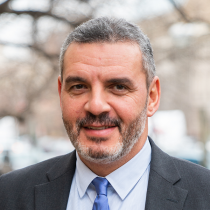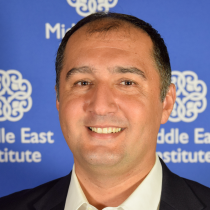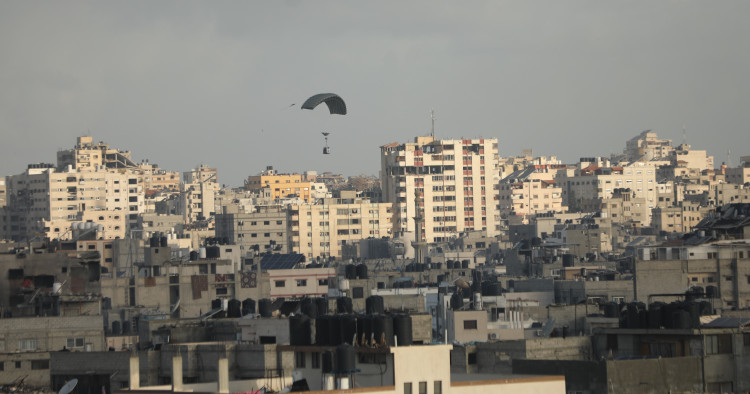Contents:
- Biden administration highlights humanitarian crisis for Palestinians in Gaza
- Intra-Palestinian gathering in Moscow breaks no new ground
- Will Israel’s ultra-Orthodox be joining the IDF?
- The challenges facing new US special envoy for Sudan
- Record low turnout in Iran’s election underscores lack of faith in the Islamic Republic
- Pakistan’s new government faces poor prospects
Biden administration highlights humanitarian crisis for Palestinians in Gaza
Brian Katulis
Senior Fellow for U.S. Foreign Policy and Senior Advisor to the President

-
The United States has begun to airlift aid into the Gaza Strip and is raising increasing alarms about the deteriorating human security situation for Gazan Palestinians.
-
This increased focus on the dire conditions comes as negotiations over a possible temporary cease-fire and hostage release between Israel and Hamas continue.
The Biden administration undertook a shift in tone and policy focus in the Israel-Hamas war this past week to put the growing humanitarian crisis among Palestinian civilians in the Gaza Strip into sharper focus. Over the weekend, the United States airdropped food aid in coordination with the Royal Jordanian Airforce along the coastline in Gaza, yet another indication of just how desperate the human security situation has become for Palestinian civilians living in the warzone.
International and humanitarian organizations have raised alarms about the risks of a famine, with some reports of Palestinian children dying of malnutrition. Israeli and United Nations officials have blamed each other for the unfolding situation: The UN contends that Israel is not allowing sufficient aid into Gaza, and Israeli sources criticize the UN for shortcomings in logistics and planning. The general chaos and lack of order inside Gazan communities torn apart by the war is a key part of the challenge in distributing aid, too. Last week’s incident, when more than 100 Palestinians were killed and 700 injured after thousands of hungry civilians rushed an aid convoy and Israeli troops fired on them, served to spotlight just how bad the situation has become for ordinary Palestinians.
President Joe Biden said late last week that his administration was going to “insist that Israel facilitate more trucks and more routes to get more and more people the help they need. No excuses, because the truth is aid flowing to Gaza is nowhere nearly enough now — it’s nowhere nearly enough.” Vice President Kamala Harris also shifted the tone and focus in remarks over the weekend, when she described the situation in Gaza as a “humanitarian catastrophe.”
Whether these shifts in tone and tactics will lead to a fundamental change in US policy remains to be seen. The airlift of humanitarian aid was small and costly compared to other means of assistance delivery. The United States has provided $180 million of aid in the Gaza crisis response since the war broke out, and the Biden administration appointed veteran US diplomat David Satterfield as special envoy for Middle East humanitarian issues early in the war. Piecemeal efforts to provide help to Palestinians have come from regional actors like Jordan and the United Arab Emirates, but there is not yet a major coordinated effort to help the people of Gaza deal with basic human concerns, including food insecurity. Clearly these moves are nowhere close to addressing the growing humanitarian security crisis in Gaza.
For now, the Biden administration continues to pin its hopes on achieving another temporary cease-fire and release of hostages from Gaza, which it sees as the lynchpin for helping address the humanitarian crisis in Gaza more holistically as well as reduce broader regional tensions before the start of Ramadan. But many major risks exist if these attempts to achieve another pause in the fighting do not succeed. It is not clear that the Biden administration has developed a coherent contingency plan if Hamas and Israel do not agree to a new deal, which has been under discussion for about three months.
Follow: @Katulis
Intra-Palestinian gathering in Moscow breaks no new ground
Khaled Elgindy
Senior Fellow, Director of Program on Palestine and Palestinian-Israeli Affairs

-
Representatives of 14 major Palestinian political factions convened in Moscow last week to try to develop a unified response to Israel’s assault on Gaza as well as revive the ossified and largely dysfunctional institutions of the Palestinian national movement.
-
Although there is broad agreement on the need to form a new technocratic government as well as reform and restructure the Palestinian Liberation Organization, Fatah and Hamas continue to disagree over how to move forward on both of these.
As US, Qatari, and Egyptian officials continued to negotiate over a proposed temporary cease-fire and hostage-release deal between Israel and Hamas, representatives of 14 major Palestinian political factions convened in Moscow last week for an entirely different set of discussions. The two-day, intra-Palestinian gathering, held on Feb. 28-29 under the auspices of the Russian government, was designed to begin the process of putting the Palestinian political house in order, particularly in light of the debilitating and destabilizing 17-year-old split between Hamas and Fatah.
Israel’s devastating war in the Gaza Strip, which has already claimed more than 30,000 lives, the vast majority of them civilians, wiped out most of Gaza’s infrastructure, and brought most of its 2.3 million inhabitants to the brink of famine, underscored the urgent need for a unified and credible Palestinian leadership and for reviving the ossified and largely dysfunctional institutions of the Palestinian national movement. Russia, which has good relations with most regional actors and is one of the few major powers able to talk to all Palestinian factions, including Hamas, is keen to expand its influence in the region as a counterweight to the United States. The meeting concluded with a joint statement that affirmed the Palestinian factions’ “unity of action” in confronting and resisting Israel’s ongoing assault on Gaza and pledged to continue their dialogue in pursuit of “a comprehensive national unity” but otherwise broke no new ground.
There is broad agreement on the two core issues: the need to form a new Palestinian Authority (PA) government that can operate in both the West Bank and Gaza Strip and the goal of reviving and restructuring the Palestine Liberation Organization (PLO) to make it genuinely representative, including by incorporating Hamas and other political factions currently outside the PLO umbrella. Yet Fatah and Hamas continue to disagree over how to move forward on both. The creation of a new PA technocratic “government of national consensus,” that is, a technocratic government that does not include members of any political faction but that operates with the approval of all of them, is seen as especially pressing given the urgent needs of Gaza reconstruction and stabilization. President Mahmoud Abbas recently dismissed the government of Prime Minister Mohammad Shtayyeh, which will continue to operate in a caretaker capacity, in preparation for a new PA government, though Fatah and Hamas remain divided on its composition. Abbas is reportedly pushing for Muhammed Mustafa, the head of the Palestine Investment Fund and widely seen as one of his allies, to serve as the new prime minister, a move that is strongly opposed by Hamas.
Although a new PA government would ideally operate under the supervision of a revamped PLO leadership, both Fatah and Hamas have their own reasons for putting off the question of PLO reform. Abbas is in no hurry for Hamas to join the PLO, while Hamas insists that the matter is too sensitive and involved and should therefore wait until after the current war. In the meantime, Hamas has insisted on the creation of an inter-factional committee that would oversee the work and functions of the new technocratic government — a demand Fatah has rejected. It is unclear whether the gaps between the rival factions can be bridged anytime soon or even when these Palestinian groups will resume their dialogue. Unless and until there is agreement among them, however, it will be difficult if not impossible for any future PA government to operate in Gaza much less oversee its reconstruction or rehabilitation.
Follow: @elgindy_
Will Israel’s ultra-Orthodox be joining the IDF?
Paul Scham
Non-Resident Scholar

-
In response to lawsuits brought forward by outraged citizen groups, the Israeli Supreme Court has ordered the government to show cause for why it should not begin drafting yeshiva students into military service as of April 1.
-
The IDF has no desire to see Haredim drafted, because of the extra effort it would take to prepare them to serve; but the issue is politically existential for Prime Minister Benjamin Netanyahu, whose governing coalition depends on support from two Haredi parties.
Israel’s comprehensive draft requires military service by almost all Jewish citizens, male and female, and by men in some other groups such as Druze and Circassians (most Palestinian citizens are not drafted). The largest — and most controversial — exemption affecting Jewish men applies to “ultra-Orthodox” (Haredi, pl. Haredim) yeshiva students. When first introduced in 1948, this policy covered 400 students; but in the last year, 66,000 received such deferments, reflecting the increase of Haredim in the Israeli population from less than 1% to the current 13% (many ultra-Orthodox families have eight children or more). Meanwhile, a whole Haredi culture has developed to ensure that their men won’t be drafted. Community leaders claim that studying holy texts all day serves to protect Israel as much as do the Israel Defense Forces; others say the real reason is so that Haredi youth, who are strictly segregated from the rest of Israeli society, do not come into contact with the non-secular world and be tempted to flee the restrictive Haredi lifestyle.
The growing number of Haredi exemptions — combined with ever-increasing financial demands for Haredi institutions supported by skyrocketing numbers of Haredi voters — has created a backlash in Israeli society. In 1998, the Supreme Court ruled that the government must produce a more equitable draft law. Since then, the issue has been kicked back and forth between the government, the courts, civil society organizations demanding fairness, and Haredi institutions and parties insisting the status quo be retained. Most recently, the Supreme Court ordered the government to show cause for why it should not begin drafting yeshiva students as of April 1.
It is worth noting that the IDF has no desire to see Haredim drafted. Besides their negative attitude toward service, it is assumed that most would not meet the basic educational or fitness standards of the army. Haredim have their own independent educational “stream,” which accepts government funding but not government control. Thus, male Haredi students take little or no math beyond arithmetic; they spend virtually all their time studying holy texts, preparing them for a life of religious scholarship and little else. While the IDF, given the Gaza war, could use a few thousand more soldiers and is currently increasing service requirements slightly, it would take significant resources to prepare thousands of Haredim for military service. The lawsuits come from outraged citizen groups, not the military.
However, this is by no means an arcane dispute affecting solely yeshiva students. If the government starts drafting them, it is assumed that the two Haredi parties will immediately exit the ruling coalition, in which they hold 18 Knesset seats out of 64. Without a supporting majority in the 120-member legislature, the government would almost certainly fall, leading to new elections within three to six months. Given that Prime Minister Netanyahu currently has a favorability rate of about 19% — and his Likud party, according to current polls, would receive about 18 seats compared to the 32 it now holds — there seems little chance he would remain as prime minister after a new election. In the local elections held last week, right-wing and religious parties apparently did well, though full results aren’t available yet. However, the issues were exclusively local and the turnout far lower than in a national election, so it is unlikely to be a bellwether.
There is increasing clamor for a new national election, and some members of the special War Cabinet are growing restive. Nevertheless, if the past 28 years are any guide, the draft issue is unlikely to precipitate an end to the current government in the coming weeks; some workaround will be found. Rather, it will just add to the government’s tensions and unpopularity — and its fury at the Supreme Court.
The challenges facing new US special envoy for Sudan
Jehanne Henry
Non-Resident Scholar

-
Ten months on, the Sudanese civil war has engulfed much more territory as well as resulted in well over 13,000 dead, 10 million displaced, and around 18 million suffering from severe hunger; but the warring sides do not appear ready to stop.
-
The appointment of a new special envoy for Sudan, Tom Perriello, should signal that the United States is serious about doing everything it can to end Sudan’s disastrous and devasting war.
To say Sudan has been sidelined, downgraded, or even forgotten, is an understatement. With all eyes on Gaza and Ukraine, Sudan is rarely news. Yet the Sudanese civil war, now in its 11th month, has killed well over 13,000 (possibly double that) and forced 10 million to flee, making it one of the world’s worst crises. Why doesn’t anyone seem to care?
Luckily, it seems an influential group in the United States Congress does. Last week, US Secretary of State Antony Blinken appointed a new special envoy for Sudan, Tom Perriello. The move — one that members of Congress from both parties, along with activists and analysts, advocated for many months — should signal that the US is serious about doing everything it can to end Sudan’s disastrous and devasting war.
The stakes could not be higher. The war between the rival forces, the government’s army, the Sudanese Armed Forces (SAF), and a sprawling paramilitary, the Rapid Support Forces (RSF), has expanded. When fighting started in April 2023, it centered in Khartoum, destroying much of the city and causing vast numbers to flee, and West Darfur, where the RSF is implicated in mass atrocities against Massalit communities.
Ten months on, it has engulfed much more territory. At the close of 2023, the RSF had consolidated control in most of Darfur and advanced east to Kordofan and to Gezira, where it took over Wad Medani, Sudan’s second-largest city. This year, the SAF made gains in Omdurman and Khartoum. Both sides have recruited aggressively and receive support and materiel from external actors, which include the United Arab Emirates, Turkey, and Iran.
The war has caused unimaginable suffering for the Sudanese population. The SAF, with its long record of abuse and repression and with Islamist hard-liners in its ranks, is using familiar indiscriminate bombing tactics, resulting in countless deaths. The RSF, which grew out of the notorious Janjaweed or “devils on horses,” who committed atrocities in Darfur in the early 2000s, leaves a trail of brutality in its wake, including rapes, killings, widespread looting, and physical destruction.
Over 10 million people have had to flee their homes, nearly 2 million to neighboring countries. Most hospitals and clinics are now out of service, access to clean water and food has dwindled, telecommunications networks are down, and the United Nations says a third of the population, around 18 million, is going hungry.
But the warring sides do not appear ready to stop. Both are recruiting aggressively. Civilian defense groups have emerged in SAF areas, some of them former revolutionaries who protested against the former regime led by Omar al-Bashir. Islamist hardliners have also exhorted civilians to pick up arms to support the SAF. Fighters on all sides — but especially those from the RSF — have posted gruesome videos on social media, trophies of their exploits.
Meanwhile, mediation efforts, which started with a US-Saudi push for a cease-fire and humanitarian aid arrangements, proliferated. The sometimes-overlapping efforts have appeared to cancel each other out, however. Last month, a new initiative in Bahrain brought key external actors together, including the UAE and Egypt, which back the RSF and SAF, respectively. But the talks have not resulted in any deals yet.
In the past, the US considered Sudan a top priority; it led international efforts to end the long-running civil war in the South and to stop a state-sponsored genocide in Darfur. Moreover, Washington applauded Sudanese revolutionaries in 2019 and stood by their democratic aspirations. Even if those successes are now ancient history, the US still has a role. The new special envoy should claim it.
Follow: @jehannehenry
Record low turnout in Iran’s election underscores lack of faith in the Islamic Republic
Alex Vatanka
Director of Iran Program and Senior Fellow, Black Sea Program

-
For a majority of Iranians, this election was a referendum on the future of the Islamic Republic, and the real question now is what comes next.
-
In the 12 rounds of parliamentary elections that Iran has held since 1979, the turnout was highest when voters believed that their votes actually mattered.
As had been predicted, Iran’s March 1 election resulted in the lowest turnout since the founding of the Islamic Republic in 1979. According to data cited by Interior Minister Ahmad Vahidi, just under 41% of voters cast a ballot. The real turnout is likely lower, although it is impossible to know at this stage. A poll by Stasis Consulting published days before the election predicted a turnout of 34%.
Elections in Iran have never been free and fair. Supreme Leader Ali Khamenei effectively has the power to keep out anyone he considers a threat to his position and policies. In this round of elections, the vetting of candidates was among the most extreme to date and many prominent political figures, including former President Hassan Rouhani, were disqualified from running.
The real question now is what comes next. For a majority of Iranians this election was a referendum on the future of the Islamic Republic. Even the regime’s own voter data shows clearly that a majority of Iranians are against it. This is hardly a surprise, but the regime tent has never been this small. Even prominent former senior regime figures are becoming increasingly vocal about the need for change. Former President Mohammad Khatami opted not to vote on March 1. His critical stance is indicative of the mood in the reformist camp that is by now nearly extinguished as a channel for criticism of Khamenei. Few reformists chose to or were able to run in this election and those who did fared badly, underscoring the public’s loss of faith in the prospects for gradual reform in the Islamic Republic.
In the 12 rounds of parliamentary elections that Iran has held since 1979, the turnout was highest when voters believed that their votes actually mattered, as in 2000, when then-President Khatami’s reformists allies secured a solid majority in the Majlis. That year, turnout was just under 70%. But since then, participation has gradually declined, and this trajectory looks set to continue. The younger demographic, in particular, sees through the charade of elections in Iran and knows that Khamenei and the Revolutionary Guards basically decide all major policy matters, domestic and foreign.
In recent days, an old video clip has been circulating from a speech Khamenei gave in which he lambasted low turnout of under 40% in American elections as evidence of the illegitimacy of the leaders in Washington. This clip is now making the rounds on Persian-language social media platforms, and one has to wonder if Khamenei can see the irony.
Follow: @AlexVatanka
Pakistan’s new government faces poor prospects
Marvin G. Weinbaum
Director, Afghanistan and Pakistan Studies

-
Shehbaz Sharif of the Pakistan Muslim League-Nawaz emerged as prime minister for a second time, rallying support from seven other parties to form a coalition government; yet most observers agree that the new government is bound to be weak, unstable, and short lasting.
-
Imran Khan’s supporters, represented in parliament under the Sunni Ittehad Council banner, have made it clear they intend to vigorously oppose the new government, aiming to shorten its tenure at every opportunity.
The pandemonium observed during the initial sessions of Pakistan’s 16th National Assembly likely foretells continuing political disorder and a newly formed government in paralysis. An entrenched culture of aggressive sloganeering, brimming with political and personal attacks, seems to have permeated the 336-member body, suggesting a prevailing lack of interest in issue-based politics among the majority of the newly elected lawmakers. Shehbaz Sharif, president of the Pakistan Muslim League-Nawaz (PML-N) and younger brother of PLM-N founder Nawaz Sharif, emerged as Pakistan’s next prime minister (the 24th in the country’s history) for a second time, overcoming a shortfall of elected members by rallying support from seven other parties. This coalition helped him secure 201 votes, defeating Omar Ayub Khan of the Sunni Ittehad Council (SIC), a surrogate party for Imran Khan’s banned Pakistan Tehreek-e-Insaf (PTI). While Shehbaz Sharif reaffirmed his commitment to steering the country through its multifaceted crises and extended a charter of reconciliation to his adversaries during his acceptance speech, legislators supported by the PTI criticized his tactics as hypocritical. They branded his victory as a “sad day for democracy,” labeling the new Shehbaz government as fascist and the product of a stolen mandate.
The PTI, with its deep bench of firebrand speakers and a track record of engaging in confrontational politics, had announced its intention to vigorously oppose the newly formed eight-party coalition government, aiming to shorten its tenure at every opportunity. Khan’s SIC adherents hope to make the most of their moral victory, having secured a plurality with 91 elected parliamentary seats. Calling its opposition constructive rather than destructive, the PTI seems determined to adopt a four-point strategy that includes staging protests during assembly sessions, regularly introducing legislative resolutions against the government, pursuing legal actions, and organizing massive countrywide demonstrations. This is while Khan is also seeking international intervention to probe the Feb. 8 elections. He has written to the International Monetary Fund to ask that its program to assist the cash-strapped country be tied to an independent audit of the disputed Feb. 8 elections. Khan has also given his blessing to the lobbying of the PTI’s US supporters, who have succeeded in inducing 31 members of Congress to sign a letter to President Joe Biden urging him not to recognize a new government in Pakistan until an investigation of election interference has been conducted. All of these efforts are aimed at demonstrating the illegality of the newly formed government and forcing new elections.
The PTI has already been put on notice that the state apparatus will crack down if it continues to cause disruption. It has been warned by a senior figure in the PML-N government of strong action if it fails to play “a positive role” and continues to engage in “politics revolving around anarchy.” For its part, the government is faced with the herculean task of meeting the country’s pressing economic, political, and security challenges. Most lawmakers are ill-prepared to address the myriad issues, ranging from hyperinflation and deep sovereign debt to climate disaster, that have left Pakistan in a seemingly permanent state of crisis. They will find it especially difficult to deliver on effective governance if they are consumed with fending off the PTI and trying to keep the jailed Khan out of the political limelight. The PML-N leadership is already apprehensive about completing its five-year tenure, viewing the formation of a coalition government as a risky endeavor that could result in either success or failure.
Most observers agree that the new government is bound to be weak and unstable, and liable to have a short lifespan. Prime Minister-elect Shehbaz Sharif has himself admitted that the next two years, given the various challenges, will be difficult for the government. Despite assurances from its coalition partners, it would not take much for the government to lose the confidence of a few parties and face a parliamentary vote like the one that ousted Khan in April 2022. Then as now, much hinges on whether the government will run afoul of the military establishment. Although the Army was instrumental in assuring the Feb. 8 electoral margin needed by the PML-N and its allies and will have a heavy presence in the new government, its history of sponsorship of Sharif family regimes has invariably ended badly.
Research assistant Naad-e-Ali Sulehria contributed to this piece.
Follow: @mgweinbaum
Photo by Dawoud Abo Alkas/Anadolu via Getty Images
The Middle East Institute (MEI) is an independent, non-partisan, non-for-profit, educational organization. It does not engage in advocacy and its scholars’ opinions are their own. MEI welcomes financial donations, but retains sole editorial control over its work and its publications reflect only the authors’ views. For a listing of MEI donors, please click here.













